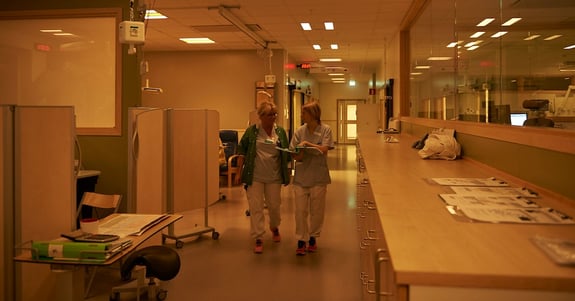Patients with individual light needs and a staff group with rotating shifts and associated sleep problems meant that the intensive care unit at Hudiksvall Hospital chose Chromaviso Circadian Lighting. A comprehensive solution that creates optimal conditions for both treatment and working environment.
As the first hospital in Sweden, Hudiksvall Hospital implemented Circadian Lighting on their general intensive care unit in 2015. The solution is Chromaviso's clinically documented Circadian Lighting, tailored to the unit's schedule as well as the diagnoses and needs of the patients. It is a comprehensive circadian solution that combines considerations for both patients and staff, incorporating both light and sound.

Better sleep and increased energy
The solution is evidence-based in clinical studies, follow-up studies, user surveys, and practical application in more than 90 hospitals. A user survey and interviews conducted at the department at Hudiksvall Hospital show that circadian lighting makes a significant difference for both patients and staff.
— It is particularly important for us because we work in three shifts. Many had difficulty falling asleep after a night shift, but when we got the light, the staff quickly noticed that they felt more refreshed at work and slept when they got home, explains Inga-Lill Bergsman, head of the intensive care unit at Hudiksvall Hospital.
She also explains that the staff experiences circadian lighting as pleasant to be in and work with, and it ensures optimal lighting around the clock, which is crucial for the work environment and safety.
Comprehensive solution
Circadian lighting stabilizes the circadian rhythm and enhances the sense of time and place. It follows natural light and evolves in a slow, gradual movement throughout the day – from gentle light in the morning to bright daylight in the middle of the day and warm, blue-free night light. The lighting is adjusted at each bed based on the individual patient's preferences and challenges, as well as the staff's need for light for individual treatment. In addition, sound masking and music therapy are integrated into the solution, creating an environment focused on integrity, calmness, and privacy in an open architecture.
Patients experience more calmness
The circadian lighting solution has had a positive impact on patients' sleep and well-being.
— The different light settings are important for the patient. It ensures the best environment for patients to sleep well, says Pia Lago-Lengquist, a nurse at the hospital, and her colleague, Kristina Löf, adds:
— The night light is good when calmness is needed, and we use the white light when, for example, we need to take a blood sample. The light settings are an important supplement to the overall circadian lighting.
In addition to sleep and calmness, the user survey shows that the staff experiences an effect on factors such as patients' risk of delirium, depression, and fatigue. These are results that have also been documented in international clinical studies conducted by Rigshospitalet, Harvard University, and Aarhus University Hospital. Other international studies have also shown that circadian lighting reduces hospitalization time and improves patient outcomes.

Monitoring rooms, bed spaces, single rooms, and corridors
The intensive care unit has Chromaviso Circadian Lighting everywhere. The lighting is controlled both at each bed space and centrally from the monitoring room through an intuitive control system. When it is evening and patients need to sleep, the lighting is turned off at their bed spaces, while the corridors and monitoring room have warm, blue-free night light that does not disturb the body's circadian rhythm but provides the necessary light for the staff's work.

Patient-oriented lighting settings
The lighting settings have been developed in close collaboration with the staff to support different situations throughout the day. During the night, when the patient is in darkness, the staff has a range of options to turn on lights that minimize disturbance to the patients. For example, a small spotlight for simple treatments or a warm, blue-free light for calming and comfort. Sound masking is also integrated to provide additional shielding against unnecessary disruptions for the patients. This means that when the acute light is turned on, speakers emit noise-masking sound to prevent any noise from disturbing other patients.


